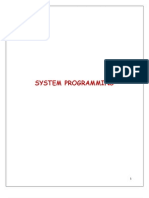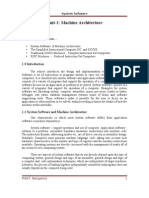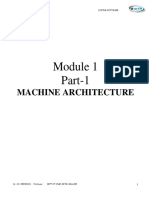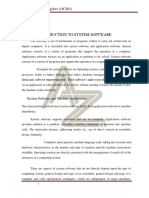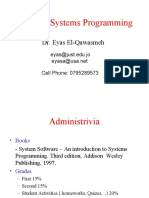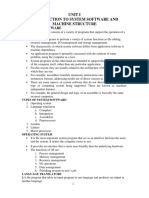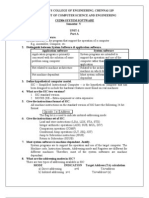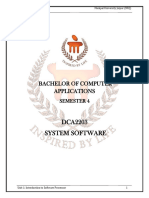SSCD Mod 1
SSCD Mod 1
Uploaded by
vickyCopyright:
Available Formats
SSCD Mod 1
SSCD Mod 1
Uploaded by
vickyOriginal Description:
Original Title
Copyright
Available Formats
Share this document
Did you find this document useful?
Is this content inappropriate?
Copyright:
Available Formats
SSCD Mod 1
SSCD Mod 1
Uploaded by
vickyCopyright:
Available Formats
System Software 15CS63
System Software
Semester : VI Course Code : 15CS63
Course Title : System Software AND Compiler Design
Faculty : Niranjan Murthy C
Dept : Computer Science & engineering
Prerequisites: Basic concepts of microprocessors (10CS45)
This course gives an introduction to the design and implementation of
Description various types of system software. A central theme of the course is the
relationship between machine architecture and system software. The
design of an assembler or an operating system is greatly influenced by
the architecture of the machine on which it runs. These influences are
emphasized and demonstrated through the discussion of actual pieces
of system softare fo a variety of real machines.
Outcomes
The students should be able to:
1. Student able to Define System Sotware such as Assembler and Macroprocessor.
2. Student able to Define System Sotware such as Loaders and Linkers
3. Student able to lexical analysis and syntax analysisFamiliaize with source file ,object and
executable file structures and libraries
4. Describe the front and back end phases of compiler and their importance to students
1 GMIT, Davangere Deepak D J
System Software 15CS63
MODULE- 1
Introduction to System Software,
Machine Architecture of SIC and SIC/XE.
Assemblers: Basic assembler functions, machine dependent assembler features,
machine independent assembler features, assembler design options.
Macroprocessors: Basic macro processor functions, ->10 Hours
MACHINE ARCHITECTURE
System Software:
System software consists of a variety of programs that support the operation of a computer.
Application software focuses on an application or problem to be solved.
System softwares are the machine dependent softwares that allows the user to focus on the
application or problem to be solved, without bothering about the details of how the
machine works internally.
Examples: Operating system, compiler, assembler, macroprocessor, loader or linker, debugger, text
editor, database management systems, etc.
Difference between System Software and application software
System Software Application Software
System software is machine dependent Application software is not dependent on the
underlying hardware.
System software focus is on the computing Application software provides solution to a
system. problem
Examples: Operating system, compiler, Examples: Antivirus, Microsoft office
assembler
SIC – Simplified Instructional Computer
Simplified Instructional Computer (SIC) is a hypothetical computer that includes the hardware
features most often found on real machines. There are two versions of SIC, they are,
standard model (SIC), and, extension version (SIC/XE) (extra equipment or extra expensive).
SIC Machine Architecture:
We discuss here the SIC machine architecture with respect to its Memory and Registers,
Data Formats, Instruction Formats, Addressing Modes, Instruction Set, Input and Output.
Memory:
There are 215 bytes in the computer memory, that is 32,768 bytes. It uses Little Endian format to
store the numbers, 3 consecutive bytes form a word , each location in memory contains 8-bit bytes.
Registers:
There are five registers, each 24 bits in length. Their mnemonic, number and use are given in the
following table.
2 GMIT, Davangere Deepak D J
System Software 15CS63
Mnemonic Number Use
A 0 Accumulator; used for arithmetic operations
X 1 Index register; used for addressing
L 2 Linkage register; JSUB
PC 8 Program counter
SW 9 Status word, including CC
Data Formats:
Integers are stored as 24-bit binary numbers. 2’s complement representation is used for negative
values, characters are stored using their 8-bit ASCII codes.No floating-point hardware on the
standard version of SIC.
Instruction Formats:
Opcode(8) x Address (15)
X is used to indicate indexed-addressing mode.
All machine instructions on the standard version of SIC have the 24-bit format as shown above.
Addressing Modes:
Only two modes are supported: Direct and Indexed
Mode Indication Target address calculation
Direct x= 0 TA = address
Indexed x= 1 TA = address + (x)
() are used to indicate the content of a register.
Instruction Set
Load and store registers (LDA, LDX, STA, STX)
Integer arithmetic (ADD, SUB, MUL, DIV), all involve register A and a word in memory.
Comparison (COMP), involve register A and a word in memory.
Conditional jump (JLE, JEQ, JGT, etc.)
Subroutine linkage (JSUB, RSUB)
Input and Output
One byte at a time to or from the rightmost 8 bits of register A.
Each device has a unique 8-bit ID code.
Test device (TD): test if a device is ready to send or receive a byte of data.
Read data (RD): read a byte from the device to register A
Write data (WD): write a byte from register A to the device.
SIC/XE Machine Architecture:
Memory
3 GMIT, Davangere Deepak D J
System Software 15CS63
Maximum memory available on a SIC/XE system is 1 Megabyte (2 20 bytes).
Registers
Additional B, S, T, and F registers are provided by SIC/XE, in addition to the registers of SIC.
Mnemonic Number Special use
B 3 Base register
S 4 General working register
T 5 General working register
F 6 Floating-point accumulator (48 bits)
Floating-point data type:
There is a 48-bit floating-point data type, F*2(e-1024)
Instruction Formats :
The new set of instruction formats fro SIC/XE machine architecture are as follows.
Format 1 (1 byte): contains only operation code (straight from table).
Format 2 (2 bytes): first eight bits for operation code, next four for register 1 and following four for
register 2. The numbers for the registers go according to the numbers indicated at the registers
section (ie, register T is replaced by hex 5, F is replaced by hex 6).
Format 3 (3 bytes): First 6 bits contain operation code, next 6 bits contain flags, last 12 bits contain
displacement for the address of the operand. Operation code uses only 6 bits, thus the second hex
digit will be affected by the values of the first two flags (n and i). The flags, in order, are: n, i, x, b, p,
and e. Its functionality is explained in the next section. The last flag e indicates the instruction format
(0 for 3 and 1 for 4).
Format 4 (4 bytes): same as format 3 with an extra 2 hex digits (8 bits) for addresses that require
more than 12 bits to be represented.
Addressing Modes:
Five possible addressing modes plus the combinations are as follows.
1. Direct (x, b, and p all set to 0): operand address goes as it is. n and i are both set to the same
value, either 0 or 1. While in general that value is 1, if set to 0 for format 3 we can assume that the
rest of the flags (x, b, p, and e) are used as a part of the address of the operand, to make the format
compatible to the SIC format.
2. Relative (either b or p equal to 1 and the other one to 0): the address of the operand should be
added to the current value stored at the B register (if b = 1) or to the value stored at the PC register
(if p = 1)
3. Immediate(i = 1, n = 0): The operand value is already enclosed on the instruction (ie. lies on the
last 12/20 bits of the instruction)
4. Indirect(i = 0, n = 1): The operand value points to an address that holds the address for the
operand value.
4 GMIT, Davangere Deepak D J
System Software 15CS63
5. Indexed (x = 1): value to be added to the value stored at the register x to obtain real address of
the operand. This can be combined with any of the previous modes except immediate.
The various flag bits used in the above formats have the following meanings
e - > e = 0 means format 3, e = 1 means format 4
Bits x,b,p : Used to calculate the target address using relative, direct, and indexed addressing Modes.
Bits i and n: Says, how to use the target address b and p - both set to 0, disp field from format 3
instruction is taken to be the target address.
For a format 4 bits b and p are normally set to 0, 20 bit address is the target address
x -x is set to 1, X register value is added for target address calculation
i=1, n=0 Immediate addressing, TA: TA is used as the operand value, no memory reference
i=0, n=1 Indirect addressing, ((TA)): The word at the TA is fetched. Value of TA is taken as the address
of the operand value
i=0, n=0 or i=1, n=1 Simple addressing, (TA):TA is taken as the address of the operand value
Two new relative addressing modes are available for use with instructions assembled using format 3.
Instruction Set:
SIC/XE provides all of the instructions that are available on the standard version. In addition we
have, Instructions to load and store the new registers LDB, STB, etc, Floating-point arithmetic
operations, ADDF, SUBF, MULF, DIVF, Register move instruction : RMO, Register-to-register
arithmetic operations, ADDR, SUBR, MULR, DIVR and, Supervisor call instruction : SVC.
Input and Output:
There are I/O channels that can be used to perform input and output while the CPU is executing
other instructions. Allows overlap of computing and I/O, resulting in more efficient system
operation. The instructions SIO, TIO, and HIO are used to start, test and halt the operation of I/O
channels.
Example programs SIC:
Example 1: Simple data and character movement operation
LDA FIVE
STA ALPHA
LDCH CHARZ
STCH C1
ALPHA RESW 1
FIVE WORD 5
CHARZ BYTE C’Z’
C1 RESB 1
Example 2: Arithmetic operations
LDA ALPHA
ADD INCR
SUB ONE
STA BETA
……..
5 GMIT, Davangere Deepak D J
System Software 15CS63
……..
……..
ONE WORD 1
ALPHA RESW 1
BEETA RESW 1
INCR RESW 1
Example 3: Looping and Indexing operation
LDX ZERO ; X=0
MOVECH LDCH STR1, X
STCH STR2, X
TIX ELEVEN
JLT MOVECH
......
......
......
STR1 BYTE C ‘HELLO WORLD’
STR2 RESB 11
ZERO WORD 0
ELEVEN WORD 11
Example 4: Input and Output operation
INLOOP TD INDEV ; TEST INPUT DEVICE
JEQ INLOOP ; LOOP UNTIL DEVICE IS READY
RD INDEV ; READ ONE BYTE INTO A
STCH DATA ; STORE A TO DATA
.
.
OUTLP TD OUTDEV ; TEST OUTPUT DEVICE
JEQ OUTLP ; LOOP UNTIL DEVICE IS READY
LDCH DATA ; LOAD DATA INTO A
WD OUTDEV ; WRITE A TO OUTPUT DEVICE
.
.
INDEV BYTE X ‘F5’ ; INPUT DEVICE NUMBER
OUTDEV BYTE X ‘08’ ; OUTPUT DEVICE NUMBER
DATA RESB 1 ; ONE-BYTE VARIABLE
Example 5: To transfer two hundred bytes of data from input device to memory
LDX ZERO
CLOOP TD INDEV
JEQ CLOOP
RD INDEV
STCH RECORD, X
TIX B200
JLT CLOOP
.
.
INDEV BYTE X ‘F5’
RECORD RESB 200
ZERO WORD 0
B200 WORD 200
6 GMIT, Davangere Deepak D J
System Software 15CS63
Example Programs (SIC/XE)
Example 1: Simple data and character movement operation
LDA #5
STA ALPHA
LDA #90
.
.
.
ALPHA RESW 1
C1 RESB 1
Example 2: Arithmetic operations
LDS INCR
LDA ALPHA
ADD S,A
SUB #1
STA BETA
…………
…………
ALPHA RESW 1
BETA RESW 1
INCR RESW 1
Example 3: Looping and Indexing operation
LDT #11
LDX #0 ;X = 0
MOVECH LDCH STR1, X ; LOAD A FROM STR1
STCH STR2, X ; STORE A TO STR2
TIXR T
JLT MOVECH
.
.
STR1 BYTE C ‘HELLO WORLD’
STR2 RESB 11
Assemblers - 1
A Simple Two-Pass Assembler
Main Functions
Translate mnemonic operation codes to their machine language equivalents
Assign machine addresses to symbolic labels used by the programmers
Depend heavily on the source language it translates and the machine language it produces.
E.g., the instruction format and addressing modes
Basic Functions of an Assembler
7 GMIT, Davangere Deepak D J
System Software 15CS63
8 GMIT, Davangere Deepak D J
System Software 15CS63
• It is a copy function that reads some records from a specified input device and then copies
them to a specified output device
– Reads a record from the input device (code F1)
– Copies the record to the output device (code 05)
– Repeats the above steps until encountering EOF.
– Then writes EOF to the output device
– Then call RSUB to return to the caller
–
RDREC and WRREC
Data transfer
– A record is a stream of bytes with a null character (0016) at the end.
– If a record is longer than 4096 bytes, only the first 4096 bytes are copied.
– EOF is indicated by a zero-length record. (I.e., a byte stream with only a null
character.
– Because the speed of the input and output devices may be different, a buffer is used
to temporarily store the record
Subroutine call and return
– On line 10, “STL RETADDR” is called to save the return address that is already stored
in register L.
– Otherwise, after calling RD or WR, this COPY cannot return back to its caller.
Assembler Directives
Assembler directives are pseudo instructions
– They will not be translated into machine instructions.
– They only provide instruction/direction/information to the assembler.
Basic assembler directives :
o START : Specify name and starting address for the program
o END : Indicate the end of the source program, and (optionally) the first executable
instruction in the program. Assembler Directives (cont’d)
o BYTE : Generate character or hexadecimal constant, occupying as many bytes as
needed to represent the constant.
9 GMIT, Davangere Deepak D J
System Software 15CS63
o WORD : Generate one-word integer constant
o RESB : Reserve the indicated number of bytes for a data area
o RESW : Reserve the indicated number of words for a data area
An Assembler’s Job
Convert mnemonic operation codes to their machine language codes
Convert symbolic (e.g., jump labels, variable names) operands to their machine addresses
Use proper addressing modes and formats to build efficient machine instructions
Translate data constants into internal machine representations
Output the object program and provide other information (e.g., for linker and loader)
Object Program Format
Header
Col. 1 H
Col. 2~7 Program name
Col. 8~13 Starting address of object program (hex)
Col. 14-19 Length of object program in bytes (hex)
Text
Col.1 T
Col.2~7 Starting address for object code in this record (hex)
Col. 8~9 Length of object code in this record in bytes (hex)
Col. 10~69 Object code, represented in hexa (2 col. per byte)
End
Col.1 E
Col.2~7 Address of first executable instruction in object program (hex)
The Object Code for COPY
H COPY 001000 00107A
T 001000 1E 141033 482039 001036 281030 301015 482061 3C1003
00102A 0C1039 00102D
T 00101E 15 0C1036 482061 081044 4C0000 454F46 000003 000000
T 002039 1E 041030 001030 E0205D 30203F D8205D 281030 302057
549039 2C205E 38203F
T 002057 1C 101036 4C0000 F1 001000 041030 E02079 302064 509039
DC2079 2C1036
10 GMIT, Davangere Deepak D J
System Software 15CS63
T 002073 07 382064 4C0000 05
E 001000
NOTE: There is no object code corresponding to addresses 1033-2038. This storage is simply
reserved by the loader for use by the program during execution.
Two Pass Assembler
Pass 1
– Assign addresses to all statements in the program
– Save the values (addresses) assigned to all labels (including label and variable
names) for use in Pass 2 (deal with forward references)
– Perform some processing of assembler directives (e.g., BYTE, RESW, these can affect
address assignment)
Pass 2
– Assemble instructions (generate opcode and look up addresses)
– Generate data values defined by BYTE, WORD
– Perform processing of assembler directives not done in Pass 1
– Write the object program and the assembly listing
A Simple Two Pass Assembler Implementation
Algorithms and Data Structures
Three Main Data Structures
• Operation Code Table (OPTAB)
• Location Counter (LOCCTR)
• Symbol Table (SYMTAB)
OPTAB (operation code table)
Content
– The mapping between mnemonic and machine code. Also include the instruction
format, available addressing modes, and length information.
Characteristic
– Static table. The content will never change.
Implementation
11 GMIT, Davangere Deepak D J
System Software 15CS63
– Array or hash table. Because the content will never change, we can optimize its
search speed.
In pass 1, OPTAB is used to look up and validate mnemonics in the source program.
In pass 2, OPTAB is used to translate mnemonics to machine instructions.
Location Counter (LOCCTR)
• This variable can help in the assignment of addresses.
• It is initialized to the beginning address specified in the START statement.
• After each source statement is processed, the length of the assembled instruction and data
area
to be generated is added to LOCCTR.
• Thus, when we reach a label in the source program, the current value of LOCCTR gives the
address to be associated with that label.
Symbol Table (SYMTAB)
• Content
– Include the label name and value (address) for each label in the source program.
– Include type and length information (e.g., int64)
– With flag to indicate errors (e.g., a symbol defined in two places)
• Characteristic
– Dynamic table (I.e., symbols may be inserted, deleted, or searched in the table)
• Implementation
– Hash table can be used to speed up search – Because variable names may be very similar
(e.g., LOOP1, LOOP2), the selected hash function must perform well with such non-random
keys.
The Pseudo Code for Pass 1
Begin
read first input line
if OPCODE = ‘START’ then begin
save #[Operand] as starting addr
initialize LOCCTR to starting address
write line to intermediate file
read next line
end( if START)
else
initialize LOCCTR to 0
While OPCODE != ‘END’ do
begin
if this is not a comment line then
12 GMIT, Davangere Deepak D J
System Software 15CS63
begin
if there is a symbol in the LABEL field then
begin
search SYMTAB for LABEL
if found then
set error flag (duplicate symbol)
else
(if symbol)
search OPTAB for OPCODE
if found then
add 3 (instr length) to LOCCTR
else if OPCODE = ‘WORD’ then
add 3 to LOCCTR
else if OPCODE = ‘RESW’ then
add 3 * #[OPERAND] to LOCCTR
else if OPCODE = ‘RESB’ then
add #[OPERAND] to LOCCTR
else if OPCODE = ‘BYTE’ then
begin
find length of constant in bytes
add length to LOCCTR
end
else
set error flag (invalid operation code)
end (if not a comment)
write line to intermediate file
read next input line
end { while not END}
write last line to intermediate file
Save (LOCCTR – starting address) as program length
13 GMIT, Davangere Deepak D J
System Software 15CS63
End {pass 1}
The Pseudo Code for Pass 2
Begin
read 1st input line
if OPCODE = ‘START’ then
begin
write listing line
read next input line
end
write Header record to object program
initialize 1st Text record
while OPCODE != ‘END’ do
begin
if this is not comment line then
begin
search OPTAB for OPCODE
if found then
begin
if there is a symbol in OPERAND field then
begin
search SYMTAB for OPERAND field then
if found then
begin
store symbol value as operand address
else
begin
store 0 as operand address
set error flag (undefined symbol)
end
14 GMIT, Davangere Deepak D J
System Software 15CS63
end (if symbol)
else store 0 as operand address
assemble the object code instruction
else if OPCODE = ‘BYTE’ or ‘WORD” then
convert constant to object code
if object code doesn’t fit into current Text record then
begin
Write text record to object code
initialize new Text record
end
add object code to Text record
end {if not comment}
write listing line
read next input line
end
write listing line
read next input line
write last listing line
End {Pass 2}
Machine dependent Assembler Features
Assembler Features
• Machine Dependent Assembler Features
– Instruction formats and addressing modes (SIC/XE)
– Program relocation
• Machine Independent Assembler Features
– Literals
– Symbol-defining statements
– Expressions
15 GMIT, Davangere Deepak D J
System Software 15CS63
– Program blocks
– Control sections and program linking
A SIC/XE Program
16 GMIT, Davangere Deepak D J
System Software 15CS63
SIC/XE Instruction Formats and Addressing Modes
• PC-relative or Base-relative (BASE directive needs to be used) addressing: op m
• Indirect addressing: op @m
• Immediate addressing: op #c
• Extended format (4 bytes): +op m
• Index addressing: op m,X
• Register-to-register instructions
Relative Addressing Modes
• PC-relative or base-relative addressing mode is preferred over direct addressing
mode.
– Can save one byte from using format 3 rather than format 4.
• Reduce program storage space
• Reduce program instruction fetch time
– Relocation will be easier.
The Differences Between the SIC and SIC/XE Programs
• Register-to-register instructions are used whenever possible to improve execution
speed.
– Fetch a value stored in a register is much faster than fetch it from the
memory.
• Immediate addressing mode is used whenever possible.
– Operand is already included in the fetched instruction. There is no need to
fetch the operand from the memory.
• Indirect addressing mode is used whenever possible.
17 GMIT, Davangere Deepak D J
System Software 15CS63
– Just one instruction rather than two is enough.
The Object Code
18 GMIT, Davangere Deepak D J
System Software 15CS63
Generate Relocatable Programs
• Let the assembled program starts at address 0 so that later it can be easily moved to
any place in the physical memory.
• Actually, as we have learned from virtual memory, now every process
(executed program) has a separate address space starting from 0.
• Assembling register-to-register instructions presents no problems. (e.g., line 125 and
150)
• Register mnemonic names need to be converted to their corresponding
register numbers.
• This can be easily done by looking up a name table.
PC or Base-Relative Modes
• Format 3: 12-bit displacement field (in total 3 bytes)
– Base-relative: 0~4095
– PC-relative: -2048~2047
• Format 4: 20-bit address field (in total 4 bytes)
• The displacement needs to be calculated so that when the displacement is added to
PC (which points to the following instruction after the current instruction is fetched)
or the base register (B), the resulting value is the target address.
• If the displacement cannot fit into 12 bits, format 4 then needs to be used. (E.g., line
15 and 125)
– Bit e needs to be set to indicate format 4.
– A programmer must specify the use of format 4 by putting a + before the
instruction. Otherwise, it will be treated as an error.
19 GMIT, Davangere Deepak D J
System Software 15CS63
Base-Relative v.s. PC-Relative
• The difference between PC and base relative addressing modes is that the assembler
knows the value of PC when it tries to use PC-relative mode to assembles an
20 GMIT, Davangere Deepak D J
System Software 15CS63
instruction. However, when trying to use base-relative mode to assemble an
instruction, the assembler does not know the value of the base register.
– Therefore, the programmer must tell the assembler the value of register B.
– This is done through the use of the BASE directive. (line 13)
– Also, the programmer must load the appropriate value into register B by
himself.
– Another BASE directive can appear later, this will tell the assembler to change
its notion of the current value of B.
– NOBASE can also be used to tell the assembler that no more base-relative
addressing mode should be used.
21 GMIT, Davangere Deepak D J
System Software 15CS63
22 GMIT, Davangere Deepak D J
System Software 15CS63
Relocatable Is Desired
• The program in Fig. 2.1 specifies that it must be loaded at address 1000 for correct
execution. This restriction is too inflexible for the loader.
• If the program is loaded at a different address, say 2000, its memory references will
access wrong data! For example:
– 55 101B LDA THREE 00102D
• Thus, we want to make programs relocatable so that they can be loaded and execute
correctly at any place in the memory.
Address Modification Is Required
If we can use a hardware relocation register (MMU), software relocation can be avoided
here. However, when linking multiple object Programs together, software relocation is still
needed.
23 GMIT, Davangere Deepak D J
System Software 15CS63
What Instructions Needs to be Modified?
• Only those instructions that use absolute (direct) addresses to reference symbols.
• The following need not be modified:
– Immediate addressing (no memory references)
– PC or Base-relative addressing (Relocatable is one advantage of relative
addressing, among others.)
– Register-to-register instructions (no memory references)
The Modification Record
• When the assembler generate an address for a symbol, the address to be inserted
into the instruction is relative to the start of the program.
• The assembler also produces a modification record, in which the address and length
of the need-to-be-modified address field are stored.
• The loader, when seeing the record, will then add the beginning address of the
loaded program to the address field stored in the record.
24 GMIT, Davangere Deepak D J
System Software 15CS63
The Relocatable Object Code
25 GMIT, Davangere Deepak D J
You might also like
- Assembly Programming:Simple, Short, And Straightforward Way Of Learning Assembly LanguageFrom EverandAssembly Programming:Simple, Short, And Straightforward Way Of Learning Assembly LanguageRating: 5 out of 5 stars5/5 (2)
- System Software and Compilers PDFDocument199 pagesSystem Software and Compilers PDFPrathiksha B.ANo ratings yet
- Ssos - U1-23Document62 pagesSsos - U1-23fayazahamed024No ratings yet
- System SoftwareDocument17 pagesSystem Softwaremandalapu_devi5240No ratings yet
- System Software Notes 5TH Sem VtuDocument15 pagesSystem Software Notes 5TH Sem VtuNeha Chinni100% (5)
- Data AnaDocument12 pagesData AnaranjithkumargruNo ratings yet
- SS Unit-1Document28 pagesSS Unit-1chethanrohit0045No ratings yet
- System Software NotesDocument104 pagesSystem Software NotesVishal PatelNo ratings yet
- cs2304 NolDocument49 pagescs2304 NolAlex DavidNo ratings yet
- System Software Unit 1Document14 pagesSystem Software Unit 1TAJCHISHTINo ratings yet
- System Software An Introduction To Systems Programming Leland L Beck 3rd Edition Addison Wesley 1997 PDFDocument40 pagesSystem Software An Introduction To Systems Programming Leland L Beck 3rd Edition Addison Wesley 1997 PDFNameera NameeraNo ratings yet
- Chapter1 PDFDocument44 pagesChapter1 PDFDivya SinghNo ratings yet
- SsDocument60 pagesSsponns100% (1)
- Chapter 1Document39 pagesChapter 1KruthikaNo ratings yet
- Sic and SIC/XEDocument14 pagesSic and SIC/XEravneet_mahal198100% (1)
- System Software and Compiler DesignDocument34 pagesSystem Software and Compiler Designsourabha DNo ratings yet
- System SoftwareDocument8 pagesSystem SoftwareSakshi JunejaNo ratings yet
- System Software and Machine Architecture Introduction2Document3 pagesSystem Software and Machine Architecture Introduction2SathyapriyaNo ratings yet
- Module-1 Part 1 AssemblersDocument22 pagesModule-1 Part 1 AssemblerssrinivasNo ratings yet
- SS-unit 1Document75 pagesSS-unit 1NIRMAL RAJESH 1860434No ratings yet
- CS1203 System Software UNIT I Question AnsDocument10 pagesCS1203 System Software UNIT I Question AnskeerthisivaNo ratings yet
- SSCD Module1Document72 pagesSSCD Module1Chirag UNo ratings yet
- SS Module 1Document72 pagesSS Module 1Yashas YashuNo ratings yet
- Examples of Systems Software AreDocument21 pagesExamples of Systems Software AreVasantha KumariNo ratings yet
- Short Questions and AnswersDocument12 pagesShort Questions and Answersrochakjyoti100% (2)
- SSCD Mod1Document75 pagesSSCD Mod1vinuthaNo ratings yet
- Computer Systems Programming: Dr. Eyas El-QawasmehDocument49 pagesComputer Systems Programming: Dr. Eyas El-QawasmehLavanya AshokNo ratings yet
- Unit I Introduction To System Software and Machine StructureDocument9 pagesUnit I Introduction To System Software and Machine StructureRam Prabesh YadavNo ratings yet
- System Software: An Introduction To Systems Programming Leland L. Beck 3rd Edition Addison-Wesley, 1997Document40 pagesSystem Software: An Introduction To Systems Programming Leland L. Beck 3rd Edition Addison-Wesley, 1997Shoyab Ahamed50% (4)
- 2 MarksDocument15 pages2 MarksraghuannamalaiNo ratings yet
- A01 Assembly LanguageDocument31 pagesA01 Assembly LanguagesouNo ratings yet
- University Solved Answers Unit 1 SS (System Software Notes)Document12 pagesUniversity Solved Answers Unit 1 SS (System Software Notes)Vaishnavi Rave100% (1)
- Important Questions For System SoftwareDocument18 pagesImportant Questions For System SoftwareKishore Rao .K XI-B2No ratings yet
- CS2304 System Software UNIT I NOTESDocument9 pagesCS2304 System Software UNIT I NOTESClashing with DeepakNo ratings yet
- System Software Question Bank 2012 With Part-B AnswersDocument49 pagesSystem Software Question Bank 2012 With Part-B Answerssumathi7975% (16)
- Unit 1Document21 pagesUnit 1sanaaaaaa0.2No ratings yet
- System Software NotesDocument97 pagesSystem Software NotesTheerthesh Gowda100% (1)
- Ss 1Document18 pagesSs 1Er Bipin VermaNo ratings yet
- KCG College of Technology, Chennai-96 Computer Science and EngineeringDocument9 pagesKCG College of Technology, Chennai-96 Computer Science and EngineeringTeja ReddyNo ratings yet
- CS2304 System Software UNIT I NOTES PDFDocument9 pagesCS2304 System Software UNIT I NOTES PDFPavankumar PkNo ratings yet
- System Software - Unit IDocument77 pagesSystem Software - Unit IJASPER WESSLYNo ratings yet
- System Software NotesDocument93 pagesSystem Software NotesNihal BanajwadNo ratings yet
- Sic, SicxeDocument39 pagesSic, SicxeSakshi jhaNo ratings yet
- Systemsoftwarenotes 100929171256 Phpapp02Document201 pagesSystemsoftwarenotes 100929171256 Phpapp02Shruthi PatilNo ratings yet
- CS6103-SP-Module 1Document39 pagesCS6103-SP-Module 1Zane JhonsonNo ratings yet
- System ProgrammingDocument28 pagesSystem Programmingjoshuajohn8281No ratings yet
- CS2304 Unit - 1Document16 pagesCS2304 Unit - 1AnaswaraNo ratings yet
- Unit-1: Machine Architecture: This Chapter Gives YouDocument14 pagesUnit-1: Machine Architecture: This Chapter Gives Yousridevi ramarajNo ratings yet
- DCA2203 - System Software Merged Sem 4thDocument424 pagesDCA2203 - System Software Merged Sem 4thadobeindustrialsystemsNo ratings yet
- SP Lesson1Document20 pagesSP Lesson1Jigmee NicNo ratings yet
- SPDocument39 pagesSPShyam JalanNo ratings yet
- System Software UNIT IDocument9 pagesSystem Software UNIT Ipalanichelvam80% (5)
- Module 1-SS&CDocument57 pagesModule 1-SS&CZaid AliNo ratings yet
- Question BankDocument91 pagesQuestion Banksaran_neoNo ratings yet
- Module 1-System SoftwareDocument60 pagesModule 1-System SoftwareVidhya MohananNo ratings yet
- Outline: System Software and Machine Architecture The Simplified Instructional Computer (SIC)Document12 pagesOutline: System Software and Machine Architecture The Simplified Instructional Computer (SIC)SENTHILKUMAR PNo ratings yet
- Prof. S.G.GollagiDocument41 pagesProf. S.G.GollagiDivya SinghNo ratings yet
- System Software Unit IDocument44 pagesSystem Software Unit IbabyNo ratings yet
- Practical Reverse Engineering: x86, x64, ARM, Windows Kernel, Reversing Tools, and ObfuscationFrom EverandPractical Reverse Engineering: x86, x64, ARM, Windows Kernel, Reversing Tools, and ObfuscationNo ratings yet
- Apple Company Introduction - Google SearchDocument1 pageApple Company Introduction - Google Searchfhtm5mrktwNo ratings yet
- X9Drg-Qf: User'S ManualDocument111 pagesX9Drg-Qf: User'S ManualPaul WengNo ratings yet
- Pipelining PDFDocument19 pagesPipelining PDFriyazpashaNo ratings yet
- ManualDocument3 pagesManualRichard the LionheartNo ratings yet
- 8051 Instruction SetDocument79 pages8051 Instruction SetpremsonyNo ratings yet
- Epson Pro 3880 Start HereDocument2 pagesEpson Pro 3880 Start HerebmmanualsNo ratings yet
- Chp#3Ex: A. JG Greater B. JL Smaller C. Ja Above D. JB BelowDocument7 pagesChp#3Ex: A. JG Greater B. JL Smaller C. Ja Above D. JB BelowUmar AsgharNo ratings yet
- HiS700 HW Health Check Procedure v1Document12 pagesHiS700 HW Health Check Procedure v1johnnywalker2000No ratings yet
- Korg Usb Manual MkiiDocument9 pagesKorg Usb Manual MkiiMarcelow FiNo ratings yet
- Advanced Computer Architecture ECE 6373: Pauline Markenscoff N320 Engineering Building 1 E-Mail: Markenscoff@uh - EduDocument151 pagesAdvanced Computer Architecture ECE 6373: Pauline Markenscoff N320 Engineering Building 1 E-Mail: Markenscoff@uh - Edurahilshah100No ratings yet
- Lenovo Thinkpad T570 Wistron LTS-1 16820-1 Rev 1 SchematDocument103 pagesLenovo Thinkpad T570 Wistron LTS-1 16820-1 Rev 1 SchematMichal MíkaNo ratings yet
- T314-12 Task Assignment - RevCDocument16 pagesT314-12 Task Assignment - RevCRio YuwandiNo ratings yet
- Design of ALUDocument44 pagesDesign of ALUAashrey JainNo ratings yet
- Toshiba Satellite 1135-S1551 Detailed SpecsDocument8 pagesToshiba Satellite 1135-S1551 Detailed SpecsHernando MontenegroNo ratings yet
- Control Processing Unit (CPU) : AssignmentDocument5 pagesControl Processing Unit (CPU) : AssignmentBlackBeardNo ratings yet
- AaaDocument46 pagesAaaJaimon JacobNo ratings yet
- 302-000-318 Emx VNXDocument23 pages302-000-318 Emx VNXEricson R N'GUESSANNo ratings yet
- DebugDocument235 pagesDebugigorfalaNo ratings yet
- Lecture#3Document17 pagesLecture#3nomi ghousNo ratings yet
- bizhub-PRESS-1250e 1250pe 1052e Brochure LRDocument8 pagesbizhub-PRESS-1250e 1250pe 1052e Brochure LRAbas AbdikadirNo ratings yet
- Chapter 10 PDFDocument25 pagesChapter 10 PDFrahmatNo ratings yet
- Igcse - Ict Year 1 Term 1 Theory Test Answer BookletDocument6 pagesIgcse - Ict Year 1 Term 1 Theory Test Answer Bookletmobahi711No ratings yet
- Register Transfer and MicrooperationsDocument45 pagesRegister Transfer and Microoperationsfahad ahmed ShNo ratings yet
- LDCODocument364 pagesLDCOCharu SharmaNo ratings yet
- Service Tool: Manual 26250 L-Series Integrated Speed ControlDocument2 pagesService Tool: Manual 26250 L-Series Integrated Speed ControlAnonymous V9fdC6No ratings yet
- EEE 342 09 Timer 8254Document33 pagesEEE 342 09 Timer 8254Hafiz Adil AsrarNo ratings yet
- Product Specification: Overdose 3Document1 pageProduct Specification: Overdose 3dragos catanaNo ratings yet
- Computer Programming 1Document52 pagesComputer Programming 1Neon JayMhell ParkNo ratings yet
- KCS 713 Unit 1 Lecture 5Document32 pagesKCS 713 Unit 1 Lecture 5piyushpandat035No ratings yet
- Price ListDocument4 pagesPrice ListDeevesh JainNo ratings yet



